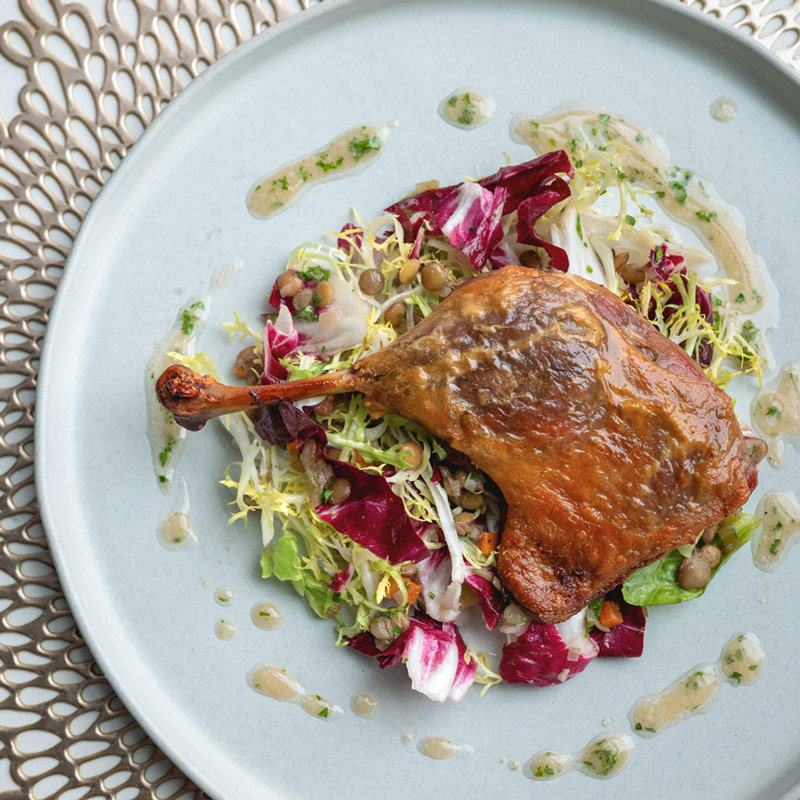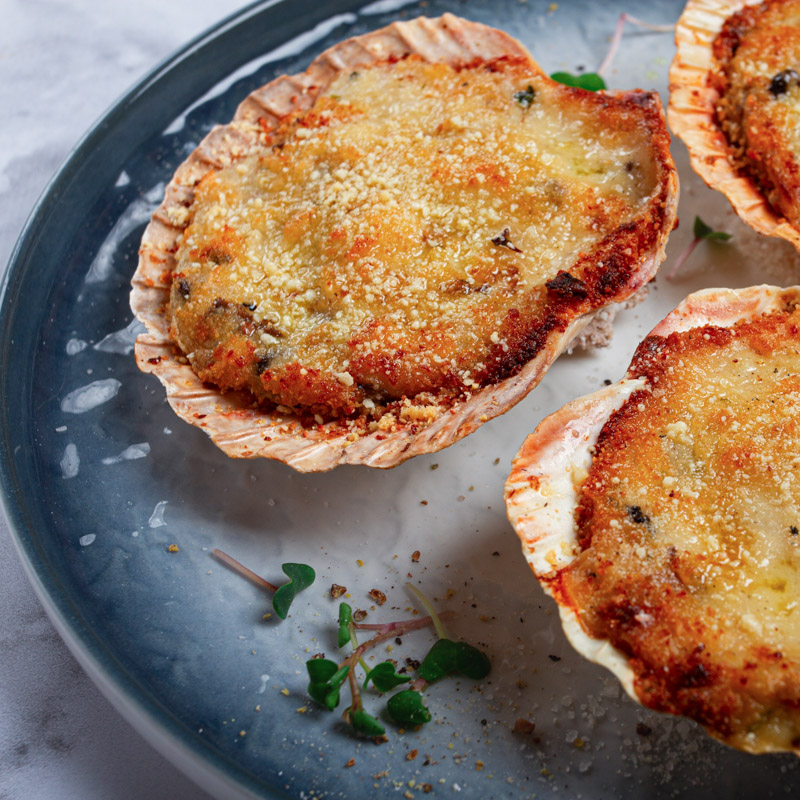Sweet, caramelized onions, briny anchovies and olives atop a savory tart are the key ingredients for this traditional Provençal gem. This recipe calls puff pastry from scratch, based on Julia Childs’ famous recipe, but you can always buy premade puff pastry from the supermarket and save 4 hours of your life. However for the purists, everything homemade is always the best!
Ingredients
For the puff pastry
- 1lb Puff pastry (total weight (Fresh dough or frozen)
- All-purpose flour (for the work surface)
- 2 3/4 cups all-purpose flour
- 3/4 cups cake flour
- 2 tsp salt
- 1/4 cup canola oil
- 1 cup ice water
- 3 sticks cold unsalted butter
For the caramelized onions
- 1/4 cup olive oil
- 3lbs yellow or sweet onions halved and thinly sliced
- 1 tsp chopped fresh thyme leaves
- fine sea salt & fresh ground pepper to taste
For the topping
- 1 large egg
- 1 tbsp water
- 24 Anchovy filets
- 1/2 cup Niçoise olives or black olives, pitted
- 6 basil leaves torn by hand
Equipment Needed
- Spatula
- Pastry scrapper
- Large mixing bowls
- Large mixing bowls
- Wax paper or parchment paper
- Plastic bags
Method for puff pastry
- Mix the dough, mix the flours with a rubber spatula. Remove ½ cup of the mixed flours and reserve for later. Drizzle the oil over the flour and mix thoroughly with a rubber spatula. Dissolve the salt in the ice water. Add the water all at once. Cutting and stirring with the spatula, mix until dough comes together. Use fingers to press the dough together. Transfer dough to working surface and press it all together into a ball. Wrap the dough in wax paper. Slip into a plastic bag and refrigerate for at least 40 min.
- Prepare the butter. Place the three sticks of butter side by side on the counter. Beat the butter with a rolling pin until it is 3/4” thick. Sprinkle the reserved 1/2" cup of mixed flours on top of the butter. Using the heel, not the palm of your hand, press the butter into the working surface to incorporate the flour into the butter. Using the bench scrapper form the butter into a 15”x12” rectangle. Open a piece of waxed paper. Using the bench scrapper lift the butter rectangle into the waxed paper. Place in refrigerator for at least 20 minutes.
- Add butter to the dough. Lightly flour your work surface. Open the chilled dough pressing with your hands. Roll it to form a 16”x18” rectangle so that the 16” side is towards you. Place the butter rectangle to one end of the dough rectangle farther from you so that the butter covers 2/3 of the dough rectangle. Leave 1/2” around the butter rectangle uncovered. The 1/3 of the dough rectangle that is not covered by the butter is closer to you and is called the flap. Fold the flap over the butter so that half of the butter is covered by it. Fold the resulting rectangle in half so that now all the butter is covered by dough. Gently press with your fingertips all around to seal the butter within the dough. Rotate the dough a quarter turn so that the shorter side is in front of you.
- Make the four-layer fold. Press with the rolling pin at intervals equal to the width of your rolling pin starting in the end close to you making small indentations in the dough all the way to the other end. Roll the dough to a 16”x18” rectangle. If there are breaks in the dough that expose the butter, sprinkle with a bit more flour. Fold both long ends of the rectangle to the center so that the two edges meet at the center. Fold again in half so that those edges are no longer visible. Press with two fingers in the middle of the folded rectangle so that you remember that you have completed the second fold. Wrap the dough in the waxed paper, slip in a plastic bag and put in the fridge for at least 40 minutes.
- Make turns 3 and 4. Unwrap the chilled dough and lightly flour it on both sides. Make indentations with your rolling pin into the dough. First lengthwise and then crosswise. This will make it easier to roll the chilled dough out. Roll the dough to a 16” x 18” rectangle. Fold this rectangle into three just like you fold a business letter. Rotate the dough a quarter turn so that the shorter side of the folded rectangle is in front of you. Roll the dough again into a 16” x 18” rectangle. Fold again like a business letter. Make four indentations on top. Wrap in the wax paper, slip into a plastic bag and put in the refrigerator. This dough has 72 layers of butter and is ready to use as is. It needs to refrigerate for two hours before using. It will last in the refrigerator for up to five days and it can be frozen.
- Make turns 5 and 6 for extra puffing . After the dough has been refrigerated for at least 40 minutes, repeat turns 3 and 4 to create 648 layers of butter.
Refrigerate for two hours before using the dough.
- Position 2 racks in the center of the oven and preheat the oven to 400°F. Line 2 large sheet pans with parchment paper. On a lighly floured work surface, roll out a puff pastry sheet to 1/4" thickness. Cut into 2 rectangles. Transfer them to a prepared sheet pan. Repeat with the second pastry sheet and transfer to the second sheet pan.
For the caramelized onions
- First, slice the onions. Aim for the slices to be as even as possible so that they cook at the same rate. Before you add them to the pan, separate the onion layers.
- Heat olive oil (I use 2 tablespoons for 4 onions) in a large cast-iron skillet over medium heat. Add the thinly sliced onions and cook for 5 minutes, stirring frequently, until the onions soften.
- Once all the onions have softened, reduce the heat to medium-low and continue to cook, stirring every few minutes. If the onions start to burn or stick to the bottom of the pan, reduce the heat to low. You could also add a splash of water if the pan starts to dry out. Add fresh thyme leaves.
- It will take 50 to 80 minutes for the onions to get deeply brown, soft, and caramelized. The exact timing will depend on the size of your pan, the size of your onions, and the heat of your stove.
Assembly
- In a small bowl using a fork, stir together the egg and water until blended. Lightly brush each pastry sheet with the egg mixture. Spread half of the onion mixture over each pastry sheet, leaving a 1/2" border on all sides. Arrange half of the anchovy fillets and half of the olives in a decorative manner on each pastry sheet.
- Place the pissaladières into the oven. Switch the pans between the racks and rotating them back to front about halfway through to ensure even baking. Bake until the edges are golden brown, about 30 minutes. Top with torn fresh basil. Cut into triangles or rectangles and enjoy. Bon Appétit!



